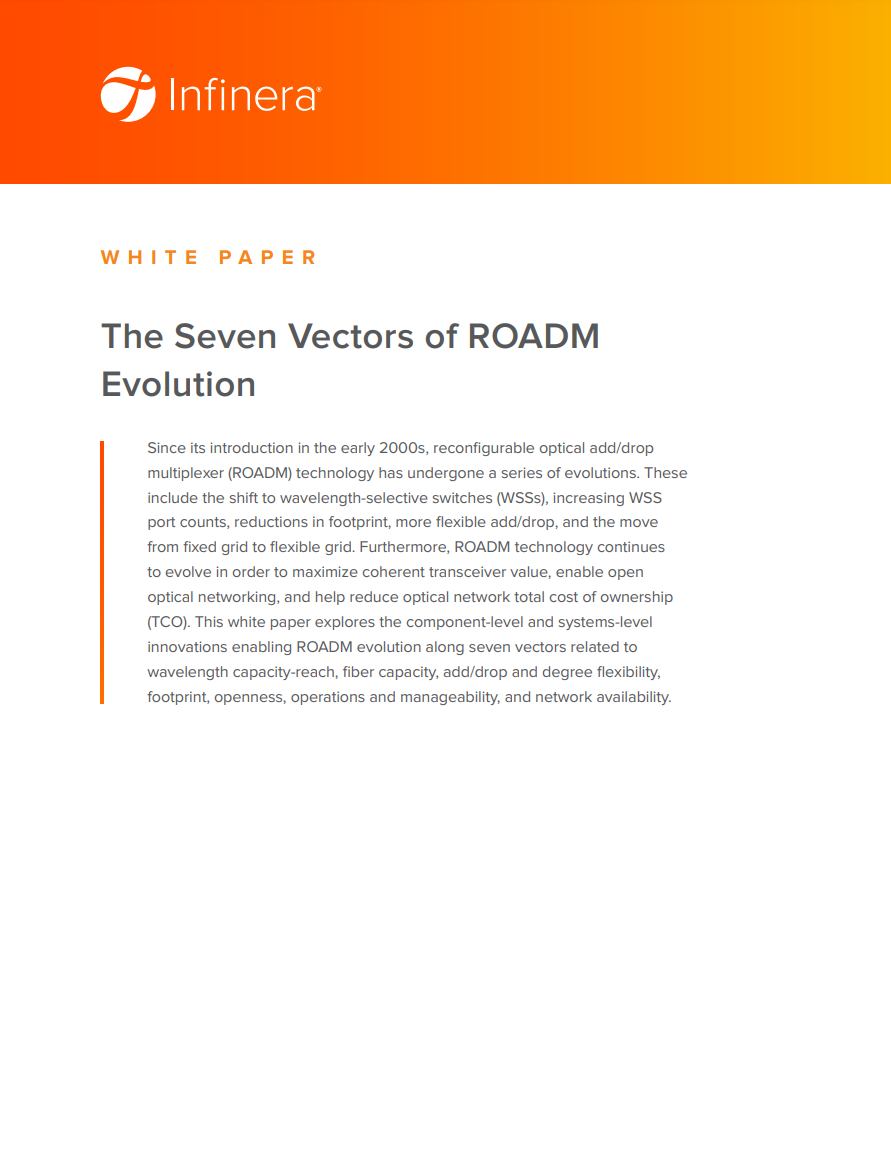Reconfigurable optical add-drop multiplexer (ROADM) technology has been around for more than 20 years since its introduction in the early 2000s. The first iterations came about following the emergence of wave division multiplexing (WDM), which tackled a rapid increase in bandwidth use by allowing more bandwidths on one fibre.
One of the first optical add-drop multiplexers was the fixed optical add-drop multiplexer (FOADM), which used fixed lasers for fixed wavelengths. This was followed by the ROADM which, it was felt, could better meet ever-growing bandwidth requirements.
Some of the first ROADMs were incorporated in around 2002 by vendors of WDM solutions across Europe and North America. They were predominantly used in long-haul networks – but as is often the case, it soon became apparent that the technology would also suit very different applications. This discovery saw ROADM start to migrate to more regional and metro networks.
In advance
Advances in ROADM technology have played a key role here; new developments since their early inception include a move to wavelength-selective switches (WSSs); increasing WSS port counts, reductions in footprint, more flexible add/drop and the shift from fixed grid to flexible grid. Today, ROADM WSS components are widely recognised for their ability to deliver flexible, uninterrupted and high-speed service to support the mesh and ring architecture.
The benefits of today’s ROADMs are widely recognised, including the speed of wavelength provisioning, the simplification of planning and the ability to extend the reach of optical transmission with wavelength power optimisation. They also serve as an enabler for optical restoration schemes that increase network availability. Such recognition is reflected in the latest figures from research firm Global Industry Analysts (GIA), which predicts that the global ROADM WSS component market will reach $1.2bn by 2026.
One of the key drivers for this, according to the report (ROADM WSS Component - Global Market Trajectory & Analytics) is a rise in demand for sophisticated components that offer flexibility while allowing efficient monitoring of network operations. It will also be propelled by extensive usage of internet services and burgeoning data traffic, which has stirred up the adoption of high-speed communication networks.
Growing market
In terms of markets, the report puts the ROADM WSS component market in the U.S. at an estimated $194.4m in the year 2021. Reasons cited for the country’s lead in this market included technological advances, as well as extensive adoption of the ROADM architecture in IT and telecommunication sectors to ensure seamless services. China is forecasted to reach $234.2m by the year 2026, while Japan and Canada are forecast to grow at 8.9 and 9.6 per cent compound annual growth rate (CAGR) respectively over the analysis period. In Europe, Germany is forecast to grow at approximately 10.8 per cent CAGR.
Of course, the industry is not one to rest on its laurels; ROADM technology continues to evolve to maximise coherent transceiver value, enable open optical networking and help reduce optical network total cost of ownership (TCO). This is the view held by Paul Momtahan, director of solutions at Infinera. ‘There are lots of things going on in the industry,’ he said. ‘There’s coherent evolution, open optical networking and also a general drive to contain total cost of ownership. This is all having a big impact on the optical line system evolution.’
Momtahan explained that there had been particular innovation and development in the component technologies that go into the optical line system. WSSs, amplifiers, filters, multicast switches, OTDRs and optical channel monitoring all saw a lot of component-level innovation. ‘There’s also a certain amount of systems-level innovation in terms of things like the link control software and the form factors for both the ROADM and the shelves,’ he said. ‘Together, these innovations are coming together and will move the optical line systems – in particular, the ROADMs – forward in terms of seven vectors. These include being able to get the most out of the coherent transceivers in terms of capacity reach; increasing the capacity of the fibre; the footprint; flexibility of degrees and add drop; openness – there’s a lot going on in terms of trying to make ROADMs more operationally easy to manage; and then increasing the availability, so you have less downtime.’
The move to openness in particular is currently a key driver for industry. Evolution to open line systems is driven by the potential to have, for example, a transponder from vendor A working over a line system of vendor B; the operator is not locked in to having the same vendor for the transponder and the line system. ‘Previously,’ explained Momtahan, ‘you put a line system in the network and it will stay there for maybe up to 10 years. But the coherent transceiver technology changes much more rapidly. And an operator doesn’t want to be locked into the vendor that they chose for the line system for 5-10 years. They could risk missing out on important innovations, because no single vendor is going to be able to dominate the innovation in all parts of the coherent engine market over 10 years.’
Another aspect to consider, he continued, is having open application programming interfaces (APIs). ‘What we’re starting to see, particularly with open ROADM,’ he said, ‘is people are looking at being able to interoperate different vendors’ ROADMs, to connect a ROADM from one vendor into a ROADM from another vendor. So that’s another area of interoperability, as probably more of a specialised case, but that is certainly a part of the open ROADM MSA and the general move to having more open optical networks.’
The future
With ROADMs evolving according to the seven vectors Momtahan mentioned, what does the future look like for this technology? ‘One question that we have seen coming up in the industry,’ he revealed, ‘comes from certain vendors questioning whether ROADMs have a role, longer-term. One in particular is saying that maybe as router silicon gets faster and faster, ROADMs aren’t needed – everything can be done by switching it through a router and having short reach optics interconnecting routers.’
However, Momtahan is not convinced. ‘We would argue that there’s a lot of benefits to having a ROADM even longer-term,’ he said. ‘The fact that the router silicon is getting faster doesn’t change that. The main disadvantage of not having a ROADM is that you end up having a lot more coherent interfaces. Even if routers were free, you save a lot of CapEx by having ROADMs to optically express wavelengths. It’s also a lot more future-proof, because you can go to the next generation of coherent technology without having to wait for your routers to be upgraded.’
Another counterpoint to this view, Momtahan added, is the continuing large market for private line services. ‘It’s very questionable whether you can do those private line services when you’re passing them through a router,’ he said. ‘Firstly, the standards don’t exist today to do that if you want to do a high-speed private line. Secondly, the products don’t exist today. The economics are quite uncertain. And thirdly, a lot of customers won’t be too happy to have their traffic pass through a router. If they’re buying 100G service from A to Z, they don’t necessarily want it to pass through some of these routers because of the security implications. It can impact latency and quality-of-service. A lot of operators that buy those wholesale services want them running at layer-one over layer-zero network, not passing through lots of routers.
This white paper explores the component-level and systems-level innovations enabling ROADM evolution along seven vectors related to wavelength capacity-reach, fibre capacity, add/drop and degree flexibility, footprint, openness, operations and manageability, and network availability.



